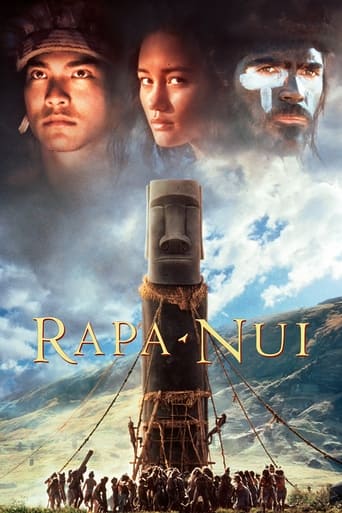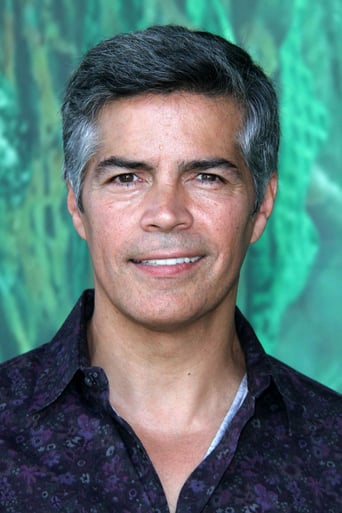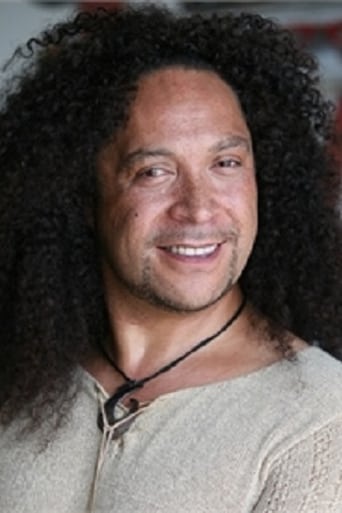Stellead
Don't listen to the Hype. It's awful
Teddie Blake
The movie turns out to be a little better than the average. Starting from a romantic formula often seen in the cinema, it ends in the most predictable (and somewhat bland) way.
Aubrey Hackett
While it is a pity that the story wasn't told with more visual finesse, this is trivial compared to our real-world problems. It takes a good movie to put that into perspective.
Phillipa
Strong acting helps the film overcome an uncertain premise and create characters that hold our attention absolutely.
tantrarubs
The inhabitants of Rapa Nui forged one of the great cultures of antiquity. They settled a small, utterly remote island in the South Pacific and developed a unique, centuries-old way of life known worldwide for creating monumental stone statues to evoke and venerate their ancestors. There is nothing like their astonishing achievement in the annals of civilization.Writer/director Kevin Reynolds distorts and insults the noble heritage of this island and its proud people with this tawdry epic. RAPA NUI seizes on lurid myths—ecocide, internecine warfare, starvation, cannibalism, and genocide--to depict past life on the isolated isle as a dismal, dog-eat-dog existence of bottomless despair and cruelty. Not so. To wit: -There is no archaeological evidence of cannibalism on Easter Island.-The Long Ears and the Short Ears, supposedly separate races or clans, probably never existed, and thus never engaged in genocidal warfare. On the contrary, Rapanui society must have been highly cooperative to carve, transport, and erect the colossal statues, as well as to cultivate crops given the island's harsh winds and challenging growing conditions.-The infamous cutting down of the 16 million trees that originally covered the island was to clear space for agriculture and grazing. Once cut, wood was put to many uses. Rolling the gigantic statues on logs was not the sole or main purpose of clear-cutting, which took place over centuries.-The religious/political cult of the birdman replaced the veneration of ancestors when the prodigious feat of making statues was no longer sustainable. Statue-carving and the birdman race were not contemporaneous.-Likewise, the statues were not being toppled as they were simultaneously being manufactured. Probably 200 years passed between the end of statue production and deposing statues in clan rivalries.Okay, viewers may not care about historical accuracy but just want some rousing entertainment. Alas, with RAPA NUI, they are still out of luck.It's supposedly a love story, but the heroine is out of sight, shut up in a cave for most of the movie. She looks hideously disheveled when she finally emerges. Yum.The Short Ears' seemingly voluntary enslavement makes no sense. Why do they put up with brutality and suffering to make statues for the priestly class? How accommodating they are! The Long Ears' power rests on the religious imperative to appease the ancestral spirits. But such moral suasion hardly offers a compelling motive for the Short Ears' elective servitude.Rapa Nui's troubles are often regarded as a microcosm for the dangers of reckless exploitation of the environment. But the film's depiction of class struggle within an enclosed society with finite resources so lacks subtlety that it is hard to take seriously as a cautionary tale for today's world.This picture contains one of the most preposterous deus ex machinas in film history. Everyone on the island wants to escape, to sail over the horizon to find a better, happier land. Ah, but there is no wood left to build boats. The answer for the delusional high priest and his gullible followers? Board an iceberg that suddenly appears.An iceberg.Really.At latitude 27 degrees south--nearly tropical waters—they might just as well have found mermaids to carry them away.As for the cast, the acting is on the see-and-say level. Everyone runs around in skimpy costumes, which at least makes for eye candy. Only Gordon Hatfield, as the heroine's father, creates a character with some depth who appears to possess emotions beyond rage, fear, and longing. His performance is the best part of the film, along with the birdman race, which seems quite authentic (except historically, the race was over when the first sooty tern egg was found on the offshore islet. The finder did have to bring it back up the cliff intact, but doing so was not part of the race).Despite being filmed entirely on location, there's a sense of artificiality about the statues. The bogus meter starts running early withthe opening credits as the camera tracks up the cliffs of the Ranu Kau volcano to three statues (nonexistent in real life) standing high on the narrow crater rim. Ridiculous. That's the last place the islanders would ever have dragged them. Statues stood on low ground, facing inland on wide platforms. These Hollywood replicas teeter on lofty heights gazing out to sea. Makes for a dramatic shot but absurd archaeology.Statues the Short Ears carve in the film look fake, big props lacking the contours and color of the originals. When the biggest one is vengefully toppled, the film cuts away the instant before it crashes. Styrofoam just doesn't shatter like rock when it hits the ground.Production of this $20 million flop in 1994 has had lasting effects for today's inhabitants of Rapa Nui. The sudden influx of film money into a hardscrabble sheep ranching existence brought about a startling transformation in island life, shifting the entire basis of the economy to tourism with remarkable swiftness.In a rather eerie redux of past ecological disasters, the island's resources now strain to accommodate 90,000 visitors per year. Discotheques rock until dawn and internet cafés dot the streets of Hanga Roa, the only town, which 30 years ago was a dirt road lined with shacks where there wasn't even a telephone. Now luxury hotels charge $1,000 per night. The standard of living in what was formerly a very sleepy place has improved exponentially.RAPA NUI, this violent, almost sadistic movie that debases the island has, ironically, presumably made it a more livable locale. Producer Kevin Costner and Warner Brothers join smallpox-carrying European explorers, Peruvian slave traders, Chilean colonialists, rapacious sheep ranchers, missionaries, and archaeologists to create the latest turning point in this fascinating island's tumultuous history.
tomsview
To judge from the derision heaped on this film, one could be forgiven for thinking it must be totally unwatchable, however, that definitely is not the case. The film was shot on location and despite liberties taken with history, it is an absorbing look at a mysterious culture that has virtually disappeared.1400 years ago, Polynesian seafarers settled on the most remote island on earth, Easter Island or Rapa Nui as they called it. Although most of what is known about their history is speculation based on archaeological evidence, it seems the island went through an intense period of statue (moai) building, followed by an equally intense period of tearing them down. In the course of which, Rapa Nui was denuded of trees and its society decimated by warfare and famine. To regulate their dwindling resources, the islanders conducted an annual ocean race with the winner's tribe ruling the island for a year under their leader, the Birdman.Kevin Reynolds' movie is about these events. In fact, every event in the island's history is in the film. What took over 1000 years to unfold takes place in what seems like a single season. Time compression is one of the major criticisms of the film.The writers constructed a Romeo and Juliet love story around the characters played by Jason Scott Lee, Sandrine Holt, and Esai Morales. This aspect of the story is quite effective due to their convincing performances. Less convincing are passages of silly dialogue between Eru Potaka-Dewes, and George Henare playing the reigning Birdman and the High Priest respectively. However, these are exceptions; the rest of the script effectively moves the story along and explains why things are happening to this doomed culture.The making and moving of the moai are highlights of the film as is the birdman competition; an event so gruelling that by comparison, a modern triathlon seems about as difficult as an egg-and-spoon race. The film recreates the event at the actual location: the cliffs at Orongo. Today it is forbidden to scale these cliffs but it seems the film was shot before the restriction existed.The score by Stewart Copeland, the former drummer of the band Police, features a blend of choral, orchestral and new age elements. A traditional score may have worked but this one is inspired, delivering a sense that time is running out for Rapa Nui.Much bare skin is exposed in the movie and nearly all the women appear topless. Gratuitousness is another charge levelled at the film, however the alternative would have been Dorothy Lamour sarongs. Historical evidence suggests the costume designers got it right, which probably pleased the marketing people who no doubt had an eye on the box office.Rapa Nui offers a very different cinema experience. It is not without the odd gaffe, but it is also totally unique and utterly compelling as well.
KFL
There seems to be some doubt among posters here as to the broader outlines of this story--the religious motivation for building the statues, and the environmental disaster this wrought. However, in broad outline this agrees with the best educated guesses of recent anthropology; see for example Chapter 1 of Clive Ponting's _A Green History of the World_. After noting that by the time of the first visits of Europeans to Easter Island in the 18th century the island had been stripped of all its trees, and that some of this lumber would have been used for building, cooking and the like, Ponting continues: "The most demanding requirement (for lumber) of all was the need to move the large number of enormously heavy statues to ceremonial sites around the island. The only way this could have been done was by large numbers of people guiding and sliding them along a form of flexible tracking made up of tree trunks spread on the ground between the quarry and the (site). Prodigious quantities of timber would have been required and in increasing amounts as the competition between the clans to erect statues grew. As a result by 1600 the island was almost completely deforested...."Thus in its broadest outlines the story told here is correct, and there must have been a kind of apocalyptic dread among the more enlightened of the residents, as the island was inexorably denuded.This portrait of a dying society, if done well, would have alone been enough to make Rapa Nui a highly interesting movie. But unintended comedic elements prevent us from taking it very seriously. On being presented with a huge statue, the result of months of work, the chief simply says "not big enough! Build another one!" ...he couldn't be bothered to vet the project in the design stage? Lines like this, and "don't bother me, I've got chicken entrails to read", and other idiotic plot twists that would constitute spoilers, dash cold water on this film as the tragic if formulaic reenactment of the final days of a doomed civilization.As others here have said, Easter Island itself is breathtaking; the beauty of the setting is one of the better things about Rapa Nui. And the story had great potential. But this movie is impossible to take seriously, and that is a shame.
petesykze
The only good thing about this film is the scenery. It's preposterously overblown, sincere and pompous, at least 90% of the cast can't act to a degree necessary for a motion picture, and the whole thing is so dull, noble and lifeless that it just sucks all energy and intelligence from you as you watch, leaving you admiring the nice pictures of forests and tropical lagoons. Even worse than 'Legends of the Fall'. 4/10 (and that's being generous)






